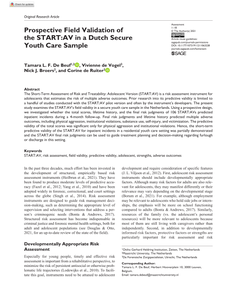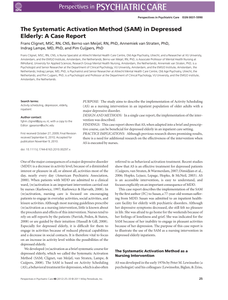Introduction: Although some adults with autism spectrum disorder (ASD) require intensive and specialized ASD treatment, there is little research on how these adults experience the recovery process. Recovery is defined as the significant improvement in general functioning compared to the situation prior to treatment. Methods: This qualitative study describes the recovery process from the perspective of adults on the autism spectrum during intensive inpatient treatment. Semi-structured interviews (n = 15) were carried out and analyzed according to the principles of grounded theory. Results: Our results indicate that, given the specific characteristics of autism, therapeutic interventions and goal-oriented work cannot be carried out successfully, and the recovery process cannot begin, if no good working relationship has been established, and if care is not organized in ways that a person on the autism spectrum finds clear and predictable.
DOCUMENT

Aggressive incidents occur frequently in health care facilities, such as psychiatric care and forensic psychiatric hospitals. Previous research suggests that civil psychiatric inpatients may display more aggression than forensic inpatients. However, there is a lack of research comparing these groups on the incident severity, even though both frequency and severity of aggression influence the impact on staff members. The purpose of this study is to compare the frequency and severity of inpatient aggression caused by forensic and civil psychiatric inpatients in the same Dutch forensic psychiatric hospital. Data on aggressive incidents occurring between January 1, 2014, and December 31, 2017, were gathered from hospital files and analyzed using the Modified Overt Aggression Scale, including sexual aggression (MOAS+). Multilevel random intercept models were used to analyze differences between forensic and civil psychiatric patients in severity of aggressive incidents. In all, 3,603 aggressive incidents were recorded, caused by 344 different patients. Civil psychiatric patients caused more aggressive incidents than forensic patients and female patients caused more inpatient aggression compared with male patients. Female forensic patients were found to cause the most severe incidents, followed by female civil psychiatric patients. Male forensic patients caused the least severe incidents. The findings have important clinical implications, such as corroborating the need for an intensive treatment program for aggressive and disruptive civil psychiatric patients, as well as emphasizing the importance of gender-responsive treatment
MULTIFILE

Inpatient violence can have a major impact in terms of traumatic experiences for victims and witnesses, an unsafe treatment climate, and high-financial costs. Therefore, the purpose of this paper is to gain more insight into patterns of violent behavior, so that adequate preventive measures can be taken.
LINK
Background: Due to the increasing number of older people with multi-morbidity, the demand for outpatient geriatric rehabilitation (OGR) will also increase. Objective: To assess the effects of OGR on the primary outcome functional performance (FP) and secondary outcomes: length of in-patient stay, re-admission rate, patients’ and caregivers’ quality of life, mortality and cost-effectiveness. We also aim to describe the organisation and content of OGR. Methods: Systematic review and meta-analysis. Five databases were queried from inception to July 2022. We selected randomised controlled trials written in English, focusing on multidisciplinary interventions related to OGR, included participants aged ≥65 and reported one of the main outcomes. A meta-analysis was performed on FP, patients’ quality of life, length of stay and re-admissions. The structural, procedural and environmental aspects of OGR were systematically mapped. Results: We selected 24 studies involving 3,405 participants. The meta-analysis showed no significant effect on the primary outcome FP (activity). It demonstrated a significant effect of OGR on shortening length of in-patient stay (P = 0.03, MD = −2.41 days, 95%CI: [−4.61—0.22]). Frequently used elements of OGR are: inpatient start of OGR with an interdisciplinary rehabilitation team, close cooperation with primary care, an OGR coordinator, individual goal setting and education for both patient and caregiver. Conclusion: This review showed that OGR is as effective as usual care on FP activity. It shows low certainty of evidence for OGR being effective in reducing the length of inpatient stay. Further research is needed on the various frequently used elements of OGR
DOCUMENT

BACKGROUND: Although enhancing physical activity (PA) is important to improve physical and/or cognitive recovery, little is known about PA of patients admitted to an inpatient rehabilitation setting. Therefore, this study assessed the quantity, nature and context of inpatients PA admitted to a rehabilitation center. METHODOLOGY/PRINICIPAL FINDINGS: Prospective observational study using accelerometry & behavioral mapping. PA of patients admitted to inpatient rehabilitation was measured during one day between 7.00-22.00 by means of 3d-accelerometery (Activ8; percentage of sedentary/active time, number of sedentary/active bouts (continuous period of ≥1 minute), and active/sedentary bout lengths and behavioral mapping. Behavioral mapping consisted of observations (every 20 minutes) to assess: type of activity, body position, social context and physical location. Descriptive statistics were used to describe PA on group and individual level. At median the 15 patients spent 81% (IQR 74%-85%) being sedentary. Patients were most sedentary in the evening (maximum sedentary bout length minutes of 69 (IQR 54-95)). During 54% (IQR 50%-61%) of the observations patients were alone) and in their room (median 50% (IQR 45%-59%)), but individual patterns varied widely. CONCLUSION/SIGNIFICANCE: The results of this study enable a deeper understanding of the daily PA patterns of patients admitted for inpatient rehabilitation treatment. PA patterns of patients differ in both quantity, day structure, social and environmental contexts. This supports the need for individualized strategies to support PA behavior during inpatient rehabilitation treatment.
DOCUMENT

Background Although enhancing physical activity (PA) is important for physical and cognitive recovery of stroke patients, the role of nurses in supporting an active lifestyle is underused during the inpatient rehabilitation treatment. Objective 1) To identify nurses’ perspectives on their current and potential role; 2) To identify influencing factors to support an active lifestyle of stroke patients during inpatient rehabilitation treatment. Methods - Three focus groups with 18 nurses (EQF level 3-6) were conducted in three Dutch rehabilitation centres (Den Haag, Leiden, Arnhem) each focus group consisting of 5-8 nurses. - The transcribed data were analysed using framework method. The data was coded by 2 researchers. Afterwards checked to align the codes and themes until consensus was reached.
DOCUMENT

The Short-Term Assessment of Risk and Treatability: Adolescent Version (START:AV) is a risk assessment instrument for adolescents that estimates the risk of multiple adverse outcomes. Prior research into its predictive validity is limited to a handful of studies conducted with the START:AV pilot version and often by the instrument’s developers. The present study examines the START:AV’s field validity in a secure youth care sample in the Netherlands. Using a prospective design, we investigated whether the total scores, lifetime history, and the final risk judgments of 106 START:AVs predicted inpatient incidents during a 4-month follow-up. Final risk judgments and lifetime history predicted multiple adverse outcomes, including physical aggression, institutional violations, substance use, self-injury, and victimization. The predictive validity of the total scores was significant only for physical aggression and institutional violations. Hence, the short-term predictive validity of the START:AV for inpatient incidents in a residential youth care setting was partially demonstrated and the START:AV final risk judgments can be used to guide treatment planning and decision-making regarding furlough or discharge in this setting.
DOCUMENT

BACKGROUND: Depression in later life is a common mental disorder with a prevalence rate of between 3% and 35% for minor depression and approximately 2% for Major Depressive Disorder (MDD). The most common treatment modalities for MDD are antidepressant medication and psychological interventions. Recently, Behavioral Activation (BA) has gained renewed attention as an effective treatment modality in MDD. Although BA is considered an easy accessible intervention for both patients and health care workers (such as nurses), there is no research on the effectiveness of the intervention in inpatient depressed elderly.The aim of study, described in the present proposal, is to examine the effects of BA when executed by nurses in an inpatient population of elderly persons with MDD. METHODS/DESIGN: The study is designed as a multi-center cluster randomized controlled trial. BA, described as The Systematic Activation Method (SAM) will be compared with Treatment as Usual (TAU). We aim to include ten mental health care units in the Netherlands that will each participate as a control unit or an experimental unit. The patients will meet the following criteria: (1) a primary diagnosis of Major Depressive Disorder (MDD) according to the DSM-IV criteria; (2) 60 years or older; (3) able to read and write in Dutch; (4) have consented to participate via the informed consent procedure. Based on an effect size d = 0.7, we intend to include 51 participants per condition (n = 102). The SAM will be implemented within the experimental units as an adjunctive therapy to Treatment As Usual (TAU). All patients will be assessed at baseline, after eight weeks, and after six months. The primary outcome will be the level of depression measured by means of the Beck Depression Inventory (Dutch version). Other assessments will be activity level, mastery, costs, anxiety and quality of life. DISCUSSION: To our knowledge this is the first study to test the effect of Behavioral Activation as a nursing intervention in an inpatient elderly population. This research has been approved by the medical research ethics committee for health-care settings in the Netherlands (No. NL26878.029.09) and is listed in the Dutch Trial Register (NTR No.1809).
DOCUMENT

Background: Physical inactivity is common during hospitalization. Physical activity has been described in different inpatient populations but never across a hospital. Purpose: To describe inpatient movement behavior and associated factors throughout a single university hospital. Methods: A prospective observational study was performed. Patients admitted to clinical wards were included. Behavioral mapping was undertaken for each participant between 9AM and 4PM. The location, physical activity, daily activity, and company of participants were described. Barriers to physical activity were examined using linear regression analyses. Results: In total, 345 participants from 19 different wards were included. The mean (SD) age was 61 (16) years and 57% of participants were male. In total, 65% of participants were able to walk independently. On average participants spent 86% of observed time in their room and 10% of their time moving. A physiotherapist or occupational therapist was present during 1% of the time, nursing staff and family were present 11% and 13%, respectively. Multivariate regression analysis showed the presence of an intravenous line (p = .039), urinary catheter (p = .031), being female (p = .034), or being dependent on others for walking (p = .016) to be positively associated with the time spent in bed. Age > 65, undergoing surgery, receiving encouragement by a nurse or physician, reporting a physical complaint or pain were not associated with the time spent in bed (P > .05). Conclusion: As family members and nursing staff spend more time with patients than physiotherapists or occupational therapists, increasing their involvement might be an important next step in the promotion of physical activity.
LINK
The study aims to describe the implementation of Activity Scheduling (AS) as a nursing intervention in an inpatient population of older adults with a major depressive disorder. DESIGN AND METHODS: In a single case report, the implementation of the intervention was described. FINDINGS: This case report shows that AS, when adapted into a brief and prescriptive course, can be beneficial for depressed elderly in an inpatient care setting. PRACTICE IMPLICATIONS: Although previous research shows promising results, there is a need for additional research on the effectiveness of the intervention when AS is executed by nurses.
DOCUMENT
